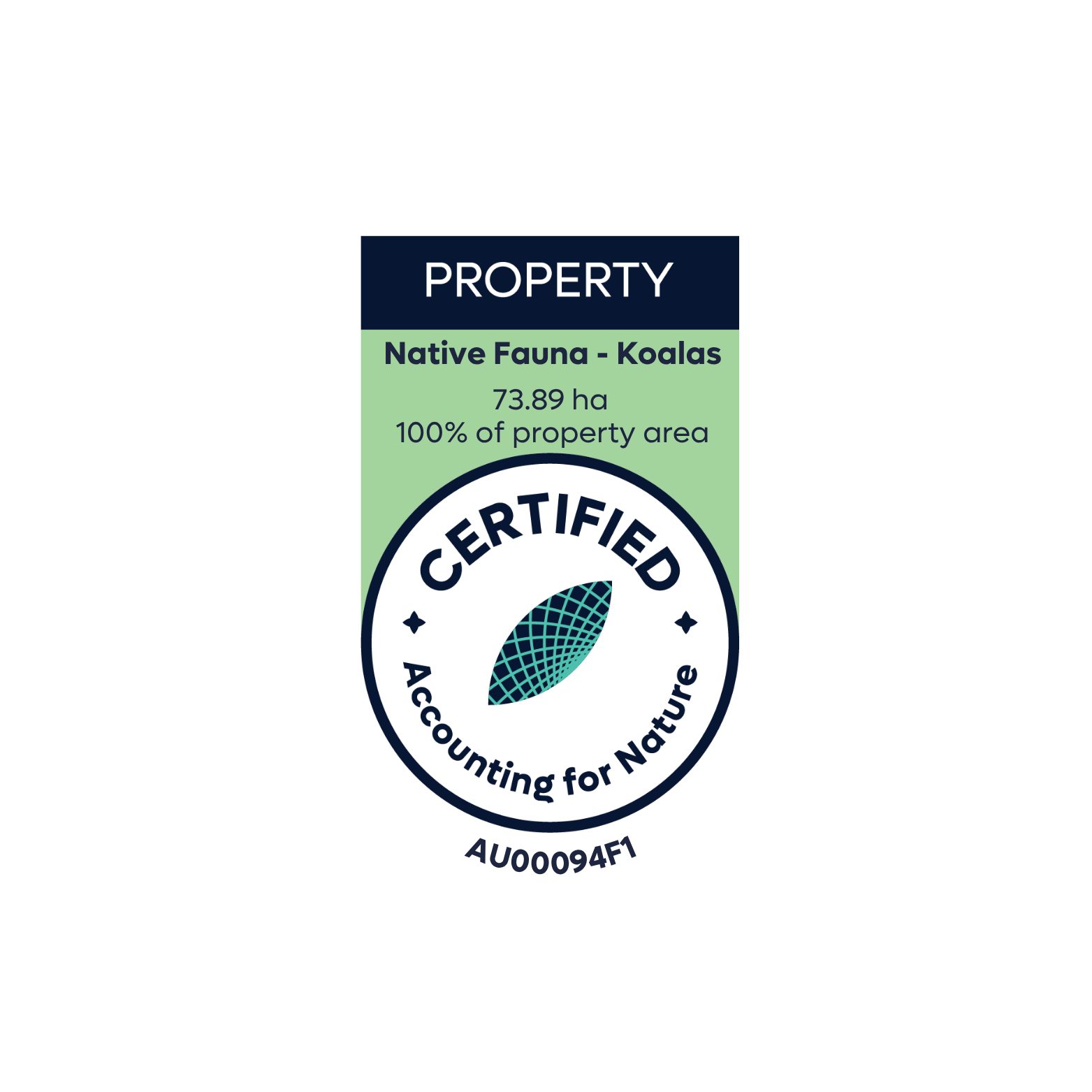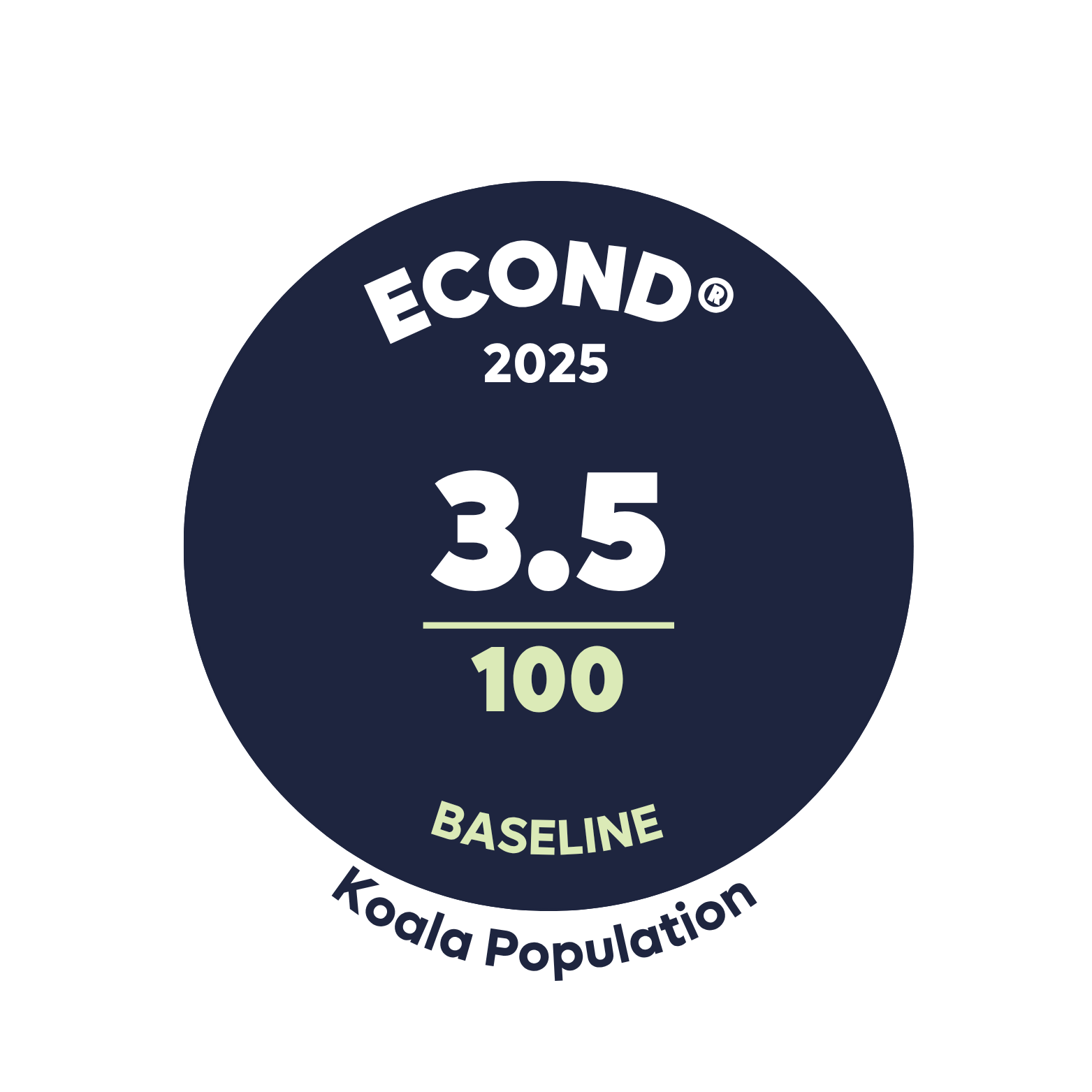Boorabee Farm Biodiversity Restoration.
Koala Habitat and Population Asset Account.
Environmental Account: AU00094
Environmental Asset: Fauna - Koala Population & Habitat Condition
Asset Account ID: AU00094F1
Registration date: 05 March 2025
Certification date: 07 November 2025
Certification pathway: AfN Verified
Purpose: Measure and track the condition and trends of koala populations and habitat over time, to facilitate data-informed decision-making.
Current land use: Conservation and Cattle Grazing
Area: 73.89 ha
Method: AfN-METHOD-F-04
Asset Account snapshot.
Asset summary - baseline.
Asset statement.
-
05 March 2025 - Registration Date
07 November 2025 - Certification date
Significant outcomes.
Koala population (Component A)
The 2025 baseline Econd® score for the Native Fauna koala population (Component A) is 3.5. Koala activity was identified at one of the 12 sampling sites for the baseline survey year 2025, in accordance with the SAT survey protocol in the vegetated assessment unit.
It is noted that two of the vegetated units are dominated by rainforest and unlikely to record koala activity. It is expected that the revegetated assessment units will support an increase in koala activity once trees can support koalas.
Koala habitat (Component B)
The 2025 baseline Econd® score for the Native Fauna koala habitat (Component B) is 48.9. Econd® scores were highest in the vegetated areas (Assessment Unit: AU03), as expected given the dominant presence of locally important and ancillary tree species (Youngentob et al., 2021). These areas scored particularly high with respect to habitat quality relative to the other Assessment Units (pre-weighted raw Econd® of 59), captured through key features and indicators, including the number of usable trees and average tree height.
The raw (pre-weighted) Econd® for the cleared areas (AU01) and CEA (AU02), are 39 and 37, respectively and the lowest of the Assessment Units, with the lowest scores across all indicator classes from landscape context, habitat quality and presence of threats.
As a baseline assessment, the outcomes from this Asset Account describe a highly modified landscape from a koala population and habitat perspective. This is considered a fair reflection of the current state from the landholders’ perspective. The quality, condition and general habitat potential vary considerably across the property, reflected in the delineation of Assessment Units and the nature and characteristics of the regrowth areas. Historical land use practices across the property, including continuous cattle grazing, have led to the fragmentation of potential koala populations and habitat.
Overall, the property offers immense potential to provide core koala habitat. Recent strategic management practice changes by the current landholders are focused on restoration, conservation and the transition of grazing areas towards a mixed forest and grazing system. Whilst these changes may be clearly evident on the ground, it is noted that such changes take time to be reflected in key impact metrics, including koala population activity and improvements in koala habitat condition.
Limitations & disclosures.
Whilst this is a property-scale assessment based on a targeted assessment of koala population and habitat condition, the focus is on the project scale where revegetation works are being conducted as part of a NSW Living Carbon grant. Therefore instead of five sites required for the 23.79ha cleared areas (as greater than 20ha), three sites were measured. Management actions of all cleared areas is expected to be consistent across the 3 cleared sites, with grazing to continue as the land use.
The indicator for koala population condition is koala activity level (KAL) which is derived using the SAT (Phillips and Callaghan 2011). SAT is a standardised, widely practiced measure of koala activity levels. However, the SAT approach can yield false negatives, particularly at lower population levels (Jiang et al 2019, Witt et al 2020), and therefore has inherent limitations on interpretation as a definite measure of presence or absence. The baseline survey was undertaken during autumn.
The Method itself describes some limitations, particularly in relation to the SAT protocol (page 5) and the availability and selection of reference benchmarks.
These limitations are deemed acceptable for the purpose of the account.
Environmental markets.
Australian Carbon Credit Unit (ACCU) Scheme project, registered with the Australian Clean Energy Regulator. More information can be found here:
Last Update: 28 October 2025

Environmental Account.
Learn more about the Environmental Account.









